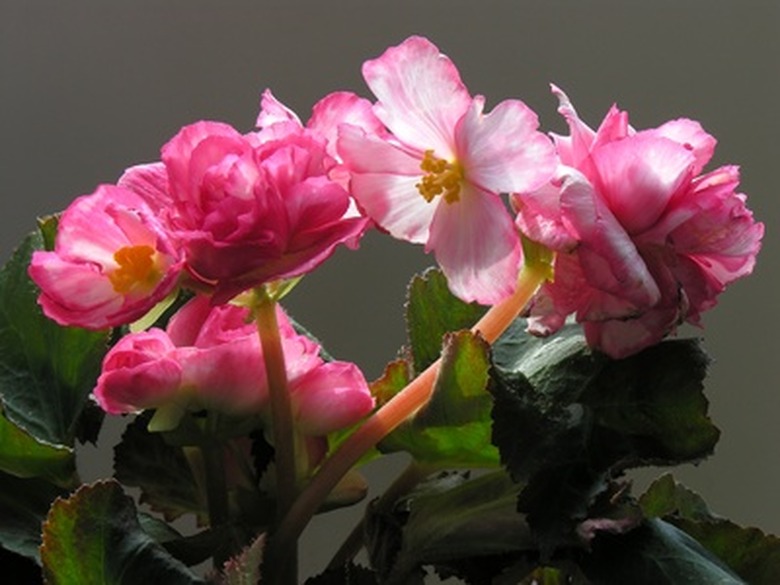How To Water Begonias
Begonias are flowering plants used as houseplants and in the garden. Landscapers select begonia varieties for their attractive foliage or flowers. Many begonia varieties do not tolerate severe winters. Cold region gardeners dig up frost-intolerant begonias prior to winter, use them as houseplants and replant outside in the spring. Some varieties do well in the sunlight while others require partial shade. Flowering time varies by begonia variety. Avoid wet and soggy soil if growing the begonia in the garden or as a potted plant indoors.
- Begonias are flowering plants used as houseplants and in the garden.
- Landscapers select begonia varieties for their attractive foliage or flowers.
Step 1
Locate a water source that is not soft water treated. If your home has soft water, draw water from a faucet that is not connected to the soft water system, such as an outside faucet.
Step 2
Schedule the watering for the early morning.
Step 3
Press your finger in the soil to test for moisture. The soil should be evenly moist and allowed to dry out slightly before re-watering. If watering a potted begonia, place the pot in the sink to catch the water.
Step 4
Irrigate the soil beneath the begonia with a low stream of water. If irrigating a potted begonia, water until it begins draining from the pot. If watering begonias in the garden, allow the soil to get thoroughly soaked without getting soggy or muddy.
- Locate a water source that is not soft water treated.
- If watering begonias in the garden, allow the soil to get thoroughly soaked without getting soggy or muddy.
Step 5
Empty the dish under the potted begonia after each watering. If you keep your potted begonia on a dish, water will collect in the dish after watering. Never allow the potted begonia to set in a dish of water.
Trim Begonias
Disinfect a pair of bypass pruners with isopropyl rubbing alcohol to prevent spreading diseases from other garden plants to your begonias. Cut or pinch off any dead leaves or stems as they occur to maintain the appearance of the begonias. Remove a new leaf as it forms, allow the plant to branch out and grow, and pinch another new tip to force branching again. Upright, cane stem begonias, such as "Angel Wing" begonias (Begonia "Angel Wing") tend to grow much taller than compact, bushy wax begonias, so they are more likely to require this type of pruning. If you grow begonias as houseplants or live in zone 10 where begonias can grow outdoors, it is best to reduce height or length in spring. Thin out as much as one-third of the total stems from compact, bushy begonias if the plant becomes too crowded and overgrown.
- Empty the dish under the potted begonia after each watering.
- Remove a new leaf as it forms, allow the plant to branch out and grow, and pinch another new tip to force branching again.
Trim Begonias
Disinfect a pair of bypass pruners with isopropyl rubbing alcohol to prevent spreading diseases from other garden plants to your begonias. Cut or pinch off any dead leaves or stems as they occur to maintain the appearance of the begonias. Remove a new leaf as it forms, allow the plant to branch out and grow, and pinch another new tip to force branching again. Upright, cane stem begonias, such as "Angel Wing" begonias (Begonia "Angel Wing") tend to grow much taller than compact, bushy wax begonias, so they are more likely to require this type of pruning. If you grow begonias as houseplants or live in zone 10 where begonias can grow outdoors, it is best to reduce height or length in spring. Thin out as much as one-third of the total stems from compact, bushy begonias if the plant becomes too crowded and overgrown.
- Empty the dish under the potted begonia after each watering.
- Remove a new leaf as it forms, allow the plant to branch out and grow, and pinch another new tip to force branching again.
Tip
Don't water tubular begonias in the winter.
References
- "Annuals"; James Crockett; 1971
- Clemson University Extension: Growing Begonias Indoors
- North Dakota State University Extension: Questions On: Begonia
- North Carolina State University Extension: Begonia Semperflorens
- Clemson Cooperative Extension: Growing Begonias Indoors
- University of Minnesota Department of Horticulture: Tuberous Begonias
- American Begonia Society: Tips for September
- North Dakota State University Extension: Questions On: Begonia
- North Carolina State University Extension: Begonia Semperflorens
- Clemson Cooperative Extension: Growing Begonias Indoors
- University of Minnesota Department of Horticulture: Tuberous Begonias
- American Begonia Society: Tips for September
